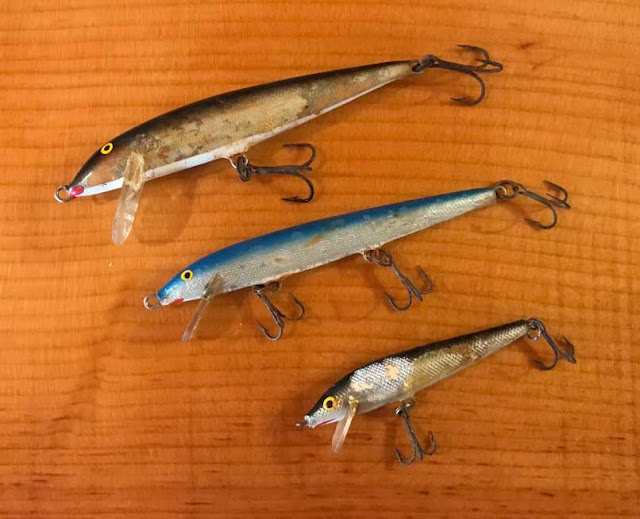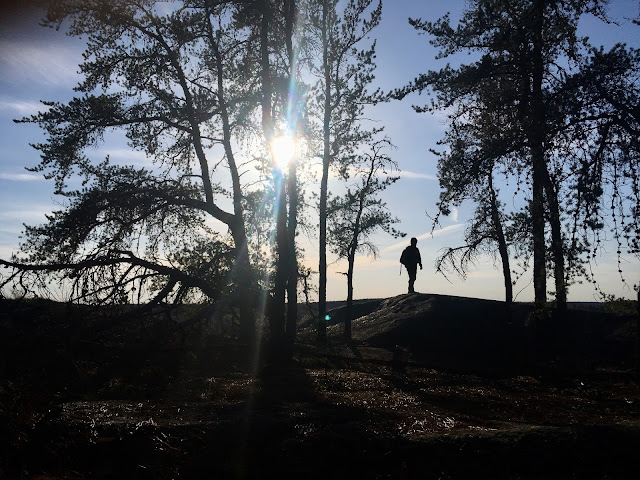Jig fishing is a time-honored nearly failsafe method for fishing for Walleye in the Boundary Waters Canoe Area Wilderness. It has many different incarnations and can lead to a variety of angler modified or inspired choices when it comes to personal preference. In short it is versatile and adaptable and requires a very limited number of parts to reach success. I like vertical jig fishing because with a little patience and of course (luck?) the right location, you can do two things well: 1) Have Fun and 2) Catch Dinner.
Traditional “ball jigs” combine a spherical weight with a hook and when the hook is tipped with bait it is a simple combination that allows an angler to take the bait down to wherever the fish are or might be. This combination allows one to fish the rocky shorelines, fallen trees, weed lines and shale piles by casting if they want to change the pace or tire of jigging.
Vertical jigging off the bottom allows your bail on your spinning reel to be open while you rest the line on your finger. Walleye often nibble or have light mouthed touches (not always — there are plenty of times they suck up your jig with force) and this approach allows you to play a little line out subtly before you set the hook. You can also close the bail and just wait for the tell-tale bobbing of the end of your rod, something that gets the blood pumping really fast. Fishing vertical drop offs, where the depth of the lake changes dramatically is a good place to start. Jigging near tips of points, and over top mounds or rises in the middle of lakes is a good option for jigs as well.
We promote non-lead alternatives in an attempt to promote Loon health. Our state bird can easily be poisoned by lead jig heads and sinkers, as they often ingest them accidentally, mistaking them for food or rocks. Tin and Bismuth make a slightly larger but no less effective jig.
Color choices can get you into many a long conversation with older more experienced anglers and those who are just superstitious, or rely on a favorite. We have a variety of water colors in the Boundary Waters lakes, from crystal clear to dark and tannin stained. It pays to have a variety of colors in your tackle box. Many people would never try darker colors, however I’ve personally proven to myself that fish must see darker colors differently than we do because black, dark blue, red have performed well for me even in darker waters. Traditional choices are yellow, chartreuse, pink, white or glow and orange.
The ideal choices to bait your jig hooks with are leeches, minnows and nightcrawlers. However, live bait is increasingly difficult to keep alive during wilderness trips that extend past a couple of days or if the weather is warm such as it is in the later weeks of July and much of August. There are a number of artificial and plastic baits that mimic the visual and swimming performance of minnows, leeches and worms. There’s even a company called of all things, Magic®, that package preserved Emerald Shiners. These shiners are traditionally a favorite bait on some Minnesota lakes where for years and years anglers have used frozen shiners that they preserved. These preserved minnows have an anise scent to them. Jigging up and down tipped with an Emerald Shiner seems to some to indeed be Magic.
It’s hard to beat a twister tail on the end of a jig. White, green or black seem to do an excellent job of exciting fish and mimicking minnows, leeches and worms.
Jigs have the downfall by nature of not being weedless and hanging up on rock piles and getting stuck. That’s why it always makes sense to take along more than you think you’ll need. It makes sense to give yourself color options and even take along some different sized jigs in case the wind comes up (the Walleye Chop isn’t famous for no reason… they like the wind, they despise direct sunlight (look at their eyes — wouldn’t you) and they also like fast moving water (fishing the tail end of rapids often produces). Tiny jigs and bits of Twisty Tails or colored fluff are excellent baits for crappie, trout and panfish.
I have to confess that I really enjoy bobber fishing and often I’ll employ a jig at the line underneath my bobber and just let my patience drift. There’s nothing quite like watching that red and white ball go under, and then go deeper. Wham!!! Dinner!
Just a side note because sometimes you want options. When I first moved to Minnesota I came across a rig called a Winkum Spin-N-Float. There’s a little float and a spinner attached to the same leader line as the perfect sized simple Walleye hook. Where this rig attached to your line you attach either a sliding weight or a few of Water Gremlin Lead Alternative Sinkers. You bait the hook with a nightcrawler or your preference and the float keeps it up off the bottom while the spinner attracts attention. Toss is out from your campsite and leave it sit while you wait for the end of your rod to bend down! When I’m not jigging or casting a countdown Rapala® or Mepps® spinner, I’m using one of these.
Once again, my fishing choices revolve around simple, classic choices that can appeal to a variety of species and produce time-honored results. Walleyes in Minnesota seem to bite on vertical ball head jigs more than just about anything else. If you don’t include Mister Twister® Tails in your pack, you should.
As one of the anglers, Mark, who replied to my last fishing blog said, “I usually paddle into the wind on a lake, and then toss one of my white twisters out and drift with the wind across the lake and usually have caught at least one northern or walleye using this method.” You see what I mean, jigs are versatile and adaptable. They allow you to develop your own style and catch fish the way you are most comfortable.






























